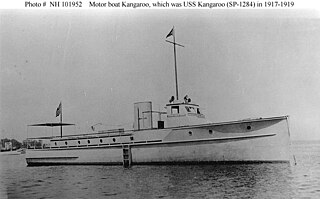
USS Sea Hawk (SP-2365) was an armed motorboat that served in the United States Navy as a patrol vessel from 1917 to 1919.

USS Edithena was a United States Navy patrol vessel in commission from 1917 to 1919 that saw service during World War I. Prior to her U.S. Navy service, she operated as the private motor yacht Edithena from 1914 to 1917. After the conclusion World War I, she served as the fishery patrol vessel USFS Widgeon in the fleet of the United States Bureau of Fisheries from 1919 to 1940 and as US FWS Widgeon in the fleet of the Fish and Wildlife Service from 1940 to 1942. During World War II, she returned to U.S. Navy service from 1942 to 1944 as the yard patrol boat USS YP-200. By 1947 she had returned to private ownership, first as Edithena and during the 1970s and 1980s as the fishing vessel Ila Mae.

The first USS Vedette (SP-163) was a commercial yacht built in 1899. At the outbreak of World War I, the yacht was leased by the United States Navy, and was used as a section patrol craft in the North Atlantic Ocean. She served honorably during the war, rescuing survivors at sea, and attacking a German U-boat. At war’s end, she was converted to her original configuration and returned to her owner, the railroad executive, financier, and philanthropist Frederick W. Vanderbilt (1856-1938) of New York City.

USS Wakiva II (SP-160), often referred to as USS Wakiva, was an armed yacht that served in the United States Navy from 1917 to 1918 and saw combat in World War I. She was originally the yacht SS Wakiva II built for Lamon V. Harkness in Scotland.

USS Anderton (SP-530), originally to have been USS Raymond J. Anderton (SP-530), was a patrol vessel and minesweeper that served in the United States Navy from 1917 to 1919.

USS Wachusetts (SP-548) was an armed motorboat that served in the United States Navy as a patrol vessel from 1917 to 1919. She was renamed SP-548 during her period of service. In 1919 she was transferred to the United States Bureau of Fisheries and renamed USFS Fulmar, and operated as a fisheries science research vessel on the Great Lakes until 1933 or 1934, when she was transferred to the Ohio Division of Conservation.

USS Wanderlust (SP-923) was a patrol vessel that served in the United States Navy from 1917 to 1919.

USS War Bug (SP-1795) was a three-armed motorboat in commission in the United States Navy as a patrol vessel from 1917 to 1918.
The first USS Lydia (SP-62) was an armed motorboat that served in the United States Navy as a patrol vessel from 1917 to 1919.

USS Rivalen (SP-63) was an armed motorboat that served in the United States Navy as a patrol vessel from 1917 to 1919.

The second USS Commodore (SP-1425) was an armed motorboat that served in the United States Navy as a patrol vessel from 1917 to 1919. It was financed by Herbert M. Sears as part of the "Eastern Yacht Club 62 footers".

USS Arizonan (ID-4542A), also written ID-4542-A was a United States Navy cargo ship and troop transport in commission from 1918 to 1919.

The first USS Kangaroo (SP-1284) was an armed motorboat that served in the United States Navy as a patrol vessel from 1917 to 1919.

USS Apache (SP-729) was the first to be delivered of eight motor boats built by Herreshoff Manufacturing Company at Bristol, Rhode Island ordered and financed by members of the Eastern Yacht Club of Marblehead, Massachusetts. The boats were designed by Albert Loring Swasey and Nathanael Greene Herreshoff with the intention that the boats be used by the Navy as patrol craft and built with Navy approval of the design. Apache, as were the other boats, bore names under construction chosen by the owners and were then given the Section Patrol numbers on Navy acceptance and activation. The names were dropped after a period and all the boats then bore only the S.P. numbers.

The second USS Cossack (SP-695) was an armed motorboat that served in the United States Navy as a patrol vessel from 1917 to 1919.

The first USS Kiowa (SP-711), later USS SP-711, was a United States Navy patrol vessel in commission from 1917 to 1918.

USS Cobra (SP-626) was a United States Navy patrol vessel in commission from 1917 to 1919 that operated during World War I. She originally was constructed as a private motorboat. After the conclusion of her U.S. Navy career, she served as the fishery patrol vessel USFS Petrel for the United States Bureau of Fisheries from 1919 to 1934, operating in the waters of the Territory of Alaska.

USS Satilla (SP-687) was a United States Navy patrol vessel in commission from 1917 to 1919.
USS Hobo II (SP-783) was a United States Navy patrol vessel in commission from 1917 to 1919.
The second USS Wissahickon (SP-852), which also served as USS SP-852, was a United States Navy patrol vessel in commission from 1917 to 1918.

















